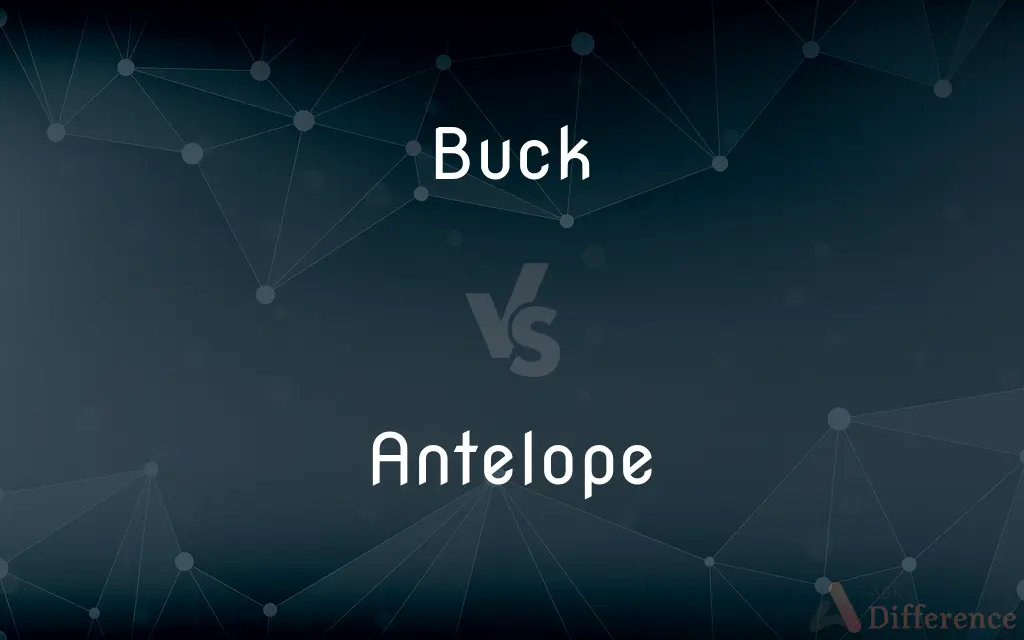Buck vs. Antelope — What's the Difference?
By Maham Liaqat & Fiza Rafique — Updated on April 9, 2024
Buck refers to a male deer, while antelope signifies a group of species, not limited by gender, known for their speed and horns.

Difference Between Buck and Antelope
Table of Contents
ADVERTISEMENT
Key Differences
A buck is specifically the term used to describe a male deer, which is a member of the cervidae family. Bucks are characterized by their antlers, which they shed and regrow annually. This term is often used in contexts related to hunting, wildlife observation, and ecology to specifically denote the male members of deer species. On the other hand, antelope refers to various species within several genera, not limited to males, found primarily in Africa and Eurasia. Antelopes are known for their impressive speed, agility, and the presence of horns in both males and females, which are permanent and do not shed annually.
While the term buck can also be used more broadly in North America to refer to the males of other species, such as antelopes or even rabbits, its primary association is with deer. This specificity contrasts with the term antelope, which encompasses a wide range of species within the Bovidae family, showcasing a diverse array of sizes, shapes, and habitats. Antelopes are adapted to a variety of environments, from dense forests to open plains, and display a wide range of social structures, from solitary animals to those living in large herds.
The ecological roles and behaviors of bucks and antelopes also differ significantly due to their varied habitats and species characteristics. Bucks, depending on their species, can play specific roles in their ecosystems, such as seed dispersal through browsing. Antelopes, with their diverse range of species, contribute to their ecosystems in numerous ways, including grazing that shapes vegetation patterns and serving as prey for large predators, thus influencing the biodiversity and trophic dynamics of their habitats.
Culturally, both bucks and antelopes have significant symbolism and importance. In many cultures, bucks are symbols of strength, virility, and agility, often featured in folklore and hunting traditions. Antelopes, with their grace and speed, symbolize a wide range of virtues and are important in the folklore and natural heritage of the regions they inhabit, especially in Africa where they are most diverse.
Despite the differences, both bucks and antelopes share common traits characteristic of their broader families, such as herbivorous diets, specialized adaptations for avoiding predators, and significance within their respective ecosystems. However, the distinction between them highlights the diversity of the animal kingdom and the specific ecological niches they occupy.
ADVERTISEMENT
Comparison Chart
Definition
Male deer, known for antlers shed annually.
Group of species, known for speed and permanent horns.
Family
Cervidae (deer family).
Bovidae (includes various species of antelope).
Horn Characteristics
Antlers, shed and regrow annually, males only.
Horns, permanent, present in both males and females.
Geographical Distribution
Primarily in North America, Europe, Asia.
Mostly in Africa, some in Asia and Eurasia.
Ecological Role
Seed dispersal, browsing impacts vegetation.
Grazing influences vegetation, prey for predators.
Symbolism
Strength, virility, agility.
Grace, speed, virtues in folklore and culture.
Social Structure
Varies by species, from solitary to herds.
Also varies widely, from solitary to large herds.
Compare with Definitions
Buck
Male deer, particularly distinguished by antlers.
The majestic buck stood alert at the forest's edge.
Antelope
Lives in diverse habitats, from forests to open plains.
Antelopes are adapted to life in a variety of environments, showcasing their ecological versatility.
Buck
Antlers as a unique feature for display and defense.
In spring, the buck sheds its antlers, which regrow in preparation for the mating season.
Antelope
Integral to their ecosystems, influencing vegetation and prey dynamics.
As a key prey species, antelopes play a crucial role in maintaining the balance of their ecosystems.
Buck
Symbol of strength and agility in many cultures.
Folklore often celebrates the buck as a creature of great endurance.
Antelope
Refers to various species within the Bovidae family, known for their horns.
The antelope grazed peacefully on the savannah.
Buck
Engages in seasonal behaviors like rutting.
The buck’s antlers were used in displays of dominance during the rut.
Antelope
Exhibits a wide range of sizes and adaptations.
From the towering eland to the diminutive dik-dik, antelopes display remarkable diversity.
Buck
Plays a role in the ecosystem as a browser.
The buck contributes to seed dispersal through its browsing habits.
Antelope
Permanent horns used for defense and mating displays.
Both male and female antelopes sport horns that they use in defense against predators.
Buck
A male deer.
Antelope
The term antelope is used to refer to many species of even-toed ruminant that are indigenous to various regions in Africa and Eurasia. Antelope comprise a wastebasket taxon (miscellaneous group) within the family Bovidae, encompassing all Old World ruminants that are not bovines, sheep, goats, deer, or giraffes.
Buck
The male of various other mammals, such as antelopes, kangaroos, mice, or rabbits.
Antelope
A swift-running deerlike ruminant with smooth hair and upward-pointing horns, of a group native to Africa and Asia that includes the gazelles, impala, gnus, and elands.
Buck
Antelope considered as a group
A herd of buck.
Antelope
Any of various swift-running ruminant mammals of the family Bovidae, native to Africa and Eurasia and having unbranched horns.
Buck
A robust or high-spirited young man.
Antelope
A pronghorn.
Buck
A fop.
Antelope
Leather made from antelope hide.
Buck
(Offensive) A Native American or black man.
Antelope
Any of several African mammals of the family Bovidae distinguished by hollow horns, which, unlike deer, they do not shed.
Buck
An act or instance of bucking
A horse that unseated its rider on the first buck.
Antelope
(US) The pronghorn, Antilocapra americana.
Buck
Buckskin.
Antelope
A fierce legendary creature said to live on the banks of the Euphrates, having long serrated horns and being hard to catch.
Buck
Bucks Buckskin breeches or shoes.
Antelope
One of a group of ruminant quadrupeds, intermediate between the deer and the goat. The horns are usually annulated, or ringed. There are many species in Africa and Asia.
The antelope and wolf both fierce and fell.
Buck
A sawhorse or sawbuck.
Antelope
Graceful Old World ruminant with long legs and horns directed upward and backward; includes gazelles; springboks; impalas; addax; gerenuks; blackbucks; dik-diks
Buck
A leather-covered frame used for gymnastic vaulting.
Buck
(Informal) A dollar.
Buck
(Informal) An amount of money
Working overtime to make an extra buck.
Buck
A large round amount of currency, especially a hundred dollars.
Buck
A hundred of some other units, especially miles per hour or pounds
Was doing a buck twenty out on the Interstate.
A boxer weighing in at a buck fifty.
Buck
(Games) A counter or marker formerly passed from one poker player to another to indicate an obligation, especially one's turn to deal.
Buck
(Informal) Obligation to account for something; responsibility
Tried to pass the buck for the failure to his boss.
Buck
To leap upward while arching the back
The horse bucked in fright.
Buck
To charge with the head lowered; butt.
Buck
To make sudden jerky movements; jolt
The motor bucked and lurched before it finally ran smoothly.
Buck
To resist stubbornly and obstinately; balk.
Buck
(Informal) To strive with determination
Bucking for a promotion.
Buck
To throw or toss by bucking
Buck off a rider.
Bucked the packsaddle off its back.
Buck
To oppose directly and stubbornly; go against
“Los Angeles County, the most populous county in the country, is bucking the trend” (American Demographics).
Buck
(Football) To charge into (an opponent's line) carrying the ball.
Buck
To butt against with the head.
Buck
To pass (a task or duty) to another, especially so as to avoid responsibility
"We will see the stifling of initiative and the increased bucking of decisions to the top" (Winston Lord).
Buck
Of the lowest rank in a specified military category
A buck private.
A buck sergeant.
Buck
A male deer, antelope, sheep, goat, rabbit, hare, and sometimes the male of other animals such as the hamster, ferret and shad.
Buck
(US) An uncastrated sheep, a ram.
Buck
A young buck; an adventurous, impetuous, dashing, or high-spirited young man.
Buck
A fop or dandy.
Buck
A black or Native American man.
Buck
A unit of a particular currency
Buck
A dollar (one hundred cents).
Can I borrow five bucks?
Buck
A rand (currency unit).
Buck
A euro.
Buck
Money.
Corporations will do anything to make a buck.
Buck
(finance) One million dollars.
Buck
One hundred.
The police caught me driving a buck forty [140 miles per hour] on the freeway.
That skinny guy? C'mon, he can't weigh more than a buck and a quarter [125 pounds].
Buck
Clipping of buckshot
He loaded the shotgun with two rounds of double-ought buck.
Buck
An implement the body of which is likened to a male sheep’s body due maintaining a stiff-legged position as if by stubbornness.
Buck
The body of a post mill, particularly in East Anglia. See Wikipedia:Windmill machinery.
Buck
A frame on which firewood is sawed; a sawhorse; a sawbuck.
Buck
A leather-covered frame used for gymnastic vaulting.
Buck
A wood or metal frame used by automotive customizers and restorers to assist in the shaping of sheet metal bodywork.
Buck
(dated) An object of various types, placed on a table to indicate turn or status; such as a brass object, placed in rotation on a US Navy wardroom dining table to indicate which officer is to be served first, or an item passed around a poker table indicating the dealer or placed in the pot to remind the winner of some privilege or obligation when his or her turn to deal next comes.
Buck
Synonym of buck dance.
Buck
Synonym of mule
Buck
A kind of large marble in children's games.
Buck
(Scotland) The beech tree.
Buck
Lye or suds in which cloth is soaked in the operation of bleaching, or in which clothes are washed.
Buck
The cloth or clothes soaked or washed.
Buck
(intransitive) To copulate, as bucks and does.
Buck
(intransitive) To bend; buckle.
Buck
To leap upward arching its back, coming down with head low and forelegs stiff, forcefully kicking its hind legs upward, often in an attempt to dislodge or throw a rider or pack.
Buck
To throw (a rider or pack) by bucking.
Buck
To subject to a mode of punishment which consists of tying the wrists together, passing the arms over the bent knees, and putting a stick across the arms and in the angle formed by the knees.
Buck
To resist obstinately; oppose or object strongly.
The vice president bucked at the board's latest solution.
Buck
To move or operate in a sharp, jerking, or uneven manner.
The motor bucked and sputtered before dying completely.
Buck
To overcome or shed (e.g., an impediment or expectation), in pursuit of a goal; to force a way through despite (an obstacle); to resist or proceed against.
The plane bucked a strong headwind.
Our managers have to learn to buck the trend and do the right thing for their employees.
John is really bucking the odds on that risky business venture. He's doing quite well.
Buck
(riveting) To press a reinforcing device (bucking bar) against (the force of a rivet) in order to absorb vibration and increase expansion. See Wikipedia: Rivet:Installation.
Buck
(forestry) To saw a felled tree into shorter lengths, as for firewood.
Buck
(electronics) To output a voltage that is lower than the input voltage. See Wikipedia: Buck converter
Buck
To soak, steep or boil in lye or suds, as part of the bleaching process.
Buck
To wash (clothes) in lye or suds, or, in later usage, by beating them on stones in running water.
Buck
(mining) To break up or pulverize, as ores.
Buck
Lye or suds in which cloth is soaked in the operation of bleaching, or in which clothes are washed.
Buck
The cloth or clothes soaked or washed.
Buck
The male of deer, especially fallow deer and antelopes, or of goats, sheep, hares, and rabbits.
Buck
A gay, dashing young fellow; a fop; a dandy.
The leading bucks of the day.
Buck
A male Indian or negro.
Buck
A frame on which firewood is sawed; a sawhorse; a sawbuck.
Buck
The beech tree.
Buck
To soak, steep, or boil, in lye or suds; - a process in bleaching.
Buck
To wash (clothes) in lye or suds, or, in later usage, by beating them on stones in running water.
Buck
To break up or pulverize, as ores.
Buck
To copulate, as bucks and does.
Buck
To spring with quick plunging leaps, descending with the fore legs rigid and the head held as low down as possible; - said of a vicious horse or mule.
Buck
To subject to a mode of punishment which consists in tying the wrists together, passing the arms over the bent knees, and putting a stick across the arms and in the angle formed by the knees.
Buck
A gymnastic horse without pommels and with one end elongated; used lengthwise for vaulting
Buck
A piece of paper money worth one dollar
Buck
United States author whose novels drew on her experiences as a missionary in China (1892-1973)
Buck
A framework for holding wood that is being sawed
Buck
Mature male of various mammals (especially deer or antelope)
Buck
To strive with determination;
John is bucking for a promotion
Buck
Resist;
Buck the trend
Buck
Move quickly and violently;
The car tore down the street
He came charging into my office
Buck
Jump vertically, with legs stiff and back arched;
The yung filly bucked
Buck
Of the lowest rank in a category;
A buck private
Common Curiosities
Can antelopes be found outside of Africa?
While antelopes are most diverse in Africa, some species are native to Asia and Eurasia, showing the group's wide geographical range.
What is the largest antelope species?
The eland is the largest antelope species, with some males weighing up to 2,000 pounds (900 kilograms).
Are antlers and horns the same?
No, antlers (found in bucks) are made of bone, shed annually, and typically grow only on males, while horns (found in antelopes) are permanent, made of a bony core and keratin sheath, and can grow on both males and females.
What are the main threats to antelope populations?
The main threats include habitat destruction, poaching, competition with livestock for grazing, and climate change, impacting their survival and reproduction rates.
Do all bucks have antlers?
Yes, in deer species, only the males, or bucks, typically grow antlers, which are shed and regrow annually.
What role do antelopes play in cultural and religious practices?
In many cultures, especially in Africa, antelopes are revered in mythology, symbolizing qualities such as agility and grace. They also feature in traditional rituals and as totems, reflecting their importance in local heritage and beliefs.
What adaptations help antelopes survive in their environments?
Antelopes have developed adaptations such as keen senses, fast and enduring running abilities, and camouflage, which help them evade predators and thrive in their habitats.
Why do bucks shed their antlers?
Bucks shed their antlers annually as part of their reproductive cycle, regrowing them in preparation for the mating season, where they serve as displays of strength and weapons in competition for mates.
Can antelopes be domesticated?
While some antelope species can adapt to living in proximity to humans, their wild nature and need for wide-ranging habitats make true domestication challenging.
How do antelopes defend themselves from predators?
Antelopes use their speed and agility to escape predators, and their horns can also be used as weapons in defense.
What role do bucks play in their ecosystems?
Bucks contribute to their ecosystems through browsing, which can influence vegetation patterns, and their antlers provide material for other animals and plants when shed.
How do antelopes contribute to biodiversity?
Antelopes play a key role in their ecosystems as grazers, controlling vegetation and serving as prey for predators, thus contributing to a balanced and diverse ecosystem.
How do antelope social structures vary across species?
Antelope social structures vary widely; some species are solitary or live in pairs, while others form large herds with complex social hierarchies, depending on their environmental and predatory pressures.
What conservation efforts are in place for antelopes?
Conservation efforts include habitat protection and restoration, anti-poaching measures, and breeding programs in wildlife reserves and parks to help sustain and increase antelope populations.
Share Your Discovery

Previous Comparison
War vs. Invasion
Next Comparison
Pseudophakia vs. AphakiaAuthor Spotlight
Written by
Maham LiaqatCo-written by
Fiza RafiqueFiza Rafique is a skilled content writer at AskDifference.com, where she meticulously refines and enhances written pieces. Drawing from her vast editorial expertise, Fiza ensures clarity, accuracy, and precision in every article. Passionate about language, she continually seeks to elevate the quality of content for readers worldwide.














































